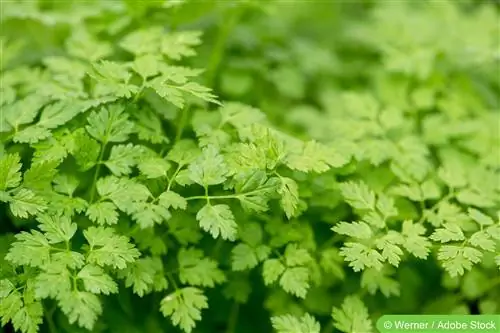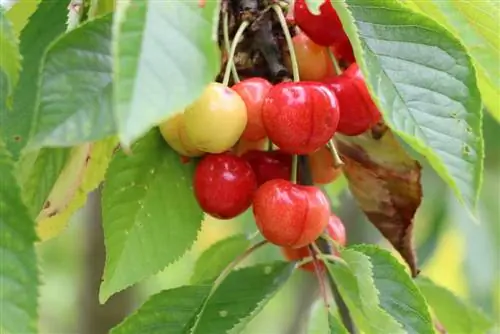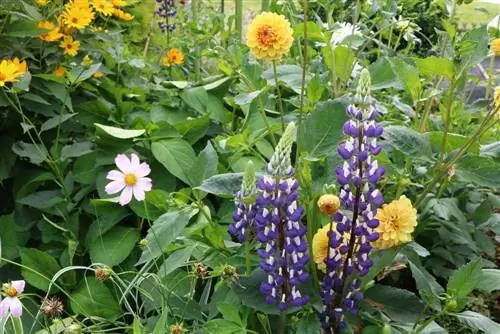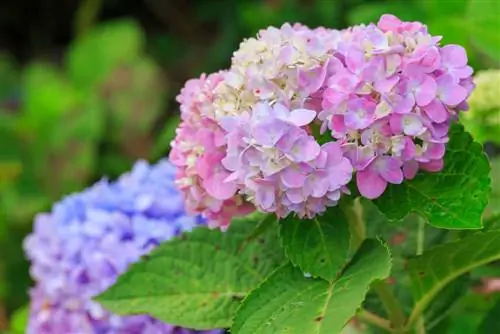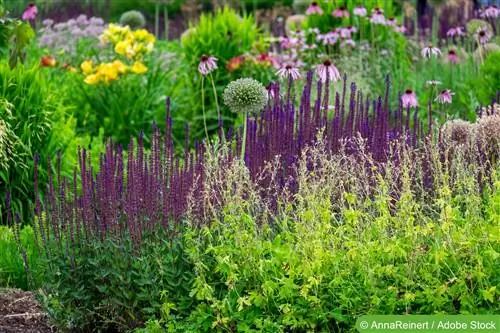- Author admin [email protected].
- Public 2023-12-17 03:39.
- Last modified 2025-06-01 06:48.
Soup herb or chervil herb - chervil is known by many names and is a delicious addition to many dishes. Especially when it is freshly harvested and goes straight onto the plate or into the pot. If you want to enjoy this, you're in luck, because growing chervil is very easy.
Delicate leaves, subtle flowers and a fine aroma - chervil is a wonderful plant long before it is seasoned. With its anise-like scent and taste, it is best enjoyed as fresh as possible. Growing your own is therefore an option. And it's easy to do even for beginners, because with the right care, the anthriscus is a fast-growing plant and quite grateful. But everything, from the choice of location to the harvest, has to really fit his requirements.
Location
The chervil or anthriscus, as it is also called, needs light to germinate and grow. However, its delicate leaves cause burns relatively quickly. The ideal location is therefore a place in partial shade, where the fragrant herb receives a lot of light but is protected from the blazing sun. A bed shaded by a tree or hedge or a sheltered corner on the balcony are ideal.
Tip:
Chervil can reach a surprising height of up to 70 cm, so there should be enough free space at the top.
Substrate
When it comes to choosing the right substrate, chervil is particularly undemanding. The soil should be able to store water but still be permeable. A moderate nutrient content is sufficient. Herbal soil, potting soil or normal garden soil mixed with a little mature compost are therefore suitable.
Sowing and planting
Growing Anthriscus can be started by sowing or planting. If you use plants that have already been grown early, you will have a faster harvest. However, you don't have to wait long for seeds to germinate. Tips for sowing:
- Place seeds directly in the bed or outdoors in a pot from mid-March
- Sowing indoors possible all year round
- only cover lightly with soil
- pay attention to even moisture
- maintain a row spacing of at least 15 cm in the bed
- the germination time is two to three weeks
If pre-grown plants are used, they should simply be planted in the bed or a pot. They can also go outside from mid-March but can just as well stay on the windowsill.
Pouring
The chervil appreciates even moisture, but not wetness. If sufficient drainage is not provided, rot and mold quickly develop. The situation is similar with drought. If you don't water for too long, the delicate leaves will die quickly or the plant will at least become susceptible to diseases and pests. Rainwater or stale tap water are recommended, but soft or medium-hard tap water is also tolerated.
Fertilize
If you want to harvest fresh chervil for a long time, you can start with light fertilization about eight weeks after sowing. Mature compost, blue grain or liquid herbal fertilizer are ideal. The doses can be given every four to eight weeks until September. However, the additional supply of nutrients is not mandatory, even for multi-year culture in the bucket.
Harvest
Harvesting chervil can begin just a few weeks after sowing and germination. If it thrives well, it can take as little as five or six weeks. To do this, simply cut off the required number of branches - but if possible not more than half of each shoot. In this way, the plant can recover well and quickly and sprout again. For more radical blends it takes a little longer.
Flowers, leaves and stems are suitable for harvesting. If anthriscus is cultivated indoors, they can even be harvested in winter.
Wintering
The chervil is frost hardy and therefore does not require any special protection in winter. However, it cannot be harvested outdoors during the winter because it loses its leaves. Depending on the type of cultivation, the Anthriscus is an annual and reproduces itself again via seeds or sprouts from the roots.
If you still want to harvest even when it's snowing outside, you either have to bring the chervil into the house in good time or cultivate it right there. It is best to bring it indoors before the first frost and put it in a bright location where normal room temperatures prevail. Watering must continue in the winter quarters, but fertilization is not necessary due to the slowed growth.
Repotting
If the chervil is in the bed, neither repotting nor annual repotting is necessary. However, changing location every two to three years can be beneficial and increase yields. It can be cultivated in a pot or bucket in a similar way. If the chervil is growing very strongly or if roots are already showing at the bottom of the pot, it should of course be repotted sooner. Spring is ideal for this measure, again mid-March.
Typical diseases and pests
Anthriscus is extremely attractive to insects, especially when it is in bloom. Unfortunately, it's not just bees and butterflies that are attracted. Aphids are also a frequent guest on the leaves. Because the chervil should of course remain edible, chemical pesticides are extremely unfavorable. It is therefore better to use the aphids' natural predators. Ladybugs, which can be purchased commercially specifically for this purpose, are particularly effective. Alternatively, the pests can be rinsed off the plants, scraped off or the affected plant parts removed.
What you should know about chervil in brief
The chervil, also known as basketweed, is now grown all over Europe. However, its roots are in the Caucasus in southern Russia. Cow parsley (Anthriscus sylvestris) is widespread in Germany.
The garden chervil (Anthriscus cerefolium) is grown and used as a soup herb and spice for vegetables or salads. With its approximately 50 cm high stems and light green leaves, chervil belongs to the genus of annual umbelliferous plants (Apiaceae). Its leaves are slightly hairy on the underside and resemble parsley. Their flowers appear in discreet white umbels. Chervil has a delicate aroma that is somewhat reminiscent of aniseed.
Cultivation
- Sufficient soil moisture is of the utmost importance for chervil, which thrives in partial shade.
- However, it does not place any special demands on the soil.
- Sowing should be spaced 15cm apart and carried out in mid-March.
- 150 grains per running meter are completely sufficient.
- It is important that you do not cover the seeds under any circumstances, because chervil is a light germinator.
- However, chervil also thrives in flower pots. Here 20 grains are enough for an 8cm deep pot.
Harvest
- The harvest is possible after approx. 5 weeks, after the germination period has ended after 14-20 days.
- Inflorescences are simply cut off.
- This step is particularly important because it keeps the leaves nice and tender.
- After 4 weeks and the first cut, a second cut is necessary and beneficial.
Uses and healing effects
Chervil has many uses these days. In the kitchen, the plant is used in sauces, soups, vegetables, stews, meat, poultry, salads, fish, herb butter, egg dishes, omelettes and quark dishes. A special tip from us: Chervil tastes best with celery leaves on buttered sandwiches or as a side dish with tomatoes and cheese. Another area of application for chervil is folk medicine. It has a stomach-strengthening, blood-purifying and dehydrating effect. It is also said to have an effect against skin inflammation and skin tumors. In cosmetics, chervil is used for compresses, steam baths or as an infusion made from chervil leaves. This works wonders, especially for oily and impure skin.
Tips & Tricks
We have a few special tips for you on the topic of chervil:
- Make sure that you never buy dried chervil, it loses its color, aroma and taste. And this distorts the taste of the chervil immensely.
- In terms of shelf life, it can be stored well in the refrigerator and can even be frozen.
- When cooking, always make sure that you only add the chervil in the last few minutes of cooking.
Frequently asked questions
Is chervil poisonous to animals?
Anthriscus itself is not poisonous to pets, but it can cause he alth problems if larger quantities are consumed. There is also the risk of confusion, which can even be fatal for adults. We're talking about hemlock, which looks very similar to chervil. This highly poisonous plant causes suffocation within a few minutes, so the supposed chervil should never be harvested in the wild.
Can I dry the chervil?
It is possible to dry the delicate chervil herb, but it is not recommended. When dried, Anthriscus loses large amounts of aroma, so that the taste diminishes significantly. This means that the amount for seasoning must be increased significantly. Freezing is better for preserving the chervil - but here too, many essential oils and thus the taste are lost. The only thing that is unbeatable is the fresh enjoyment of the soup cabbage.

